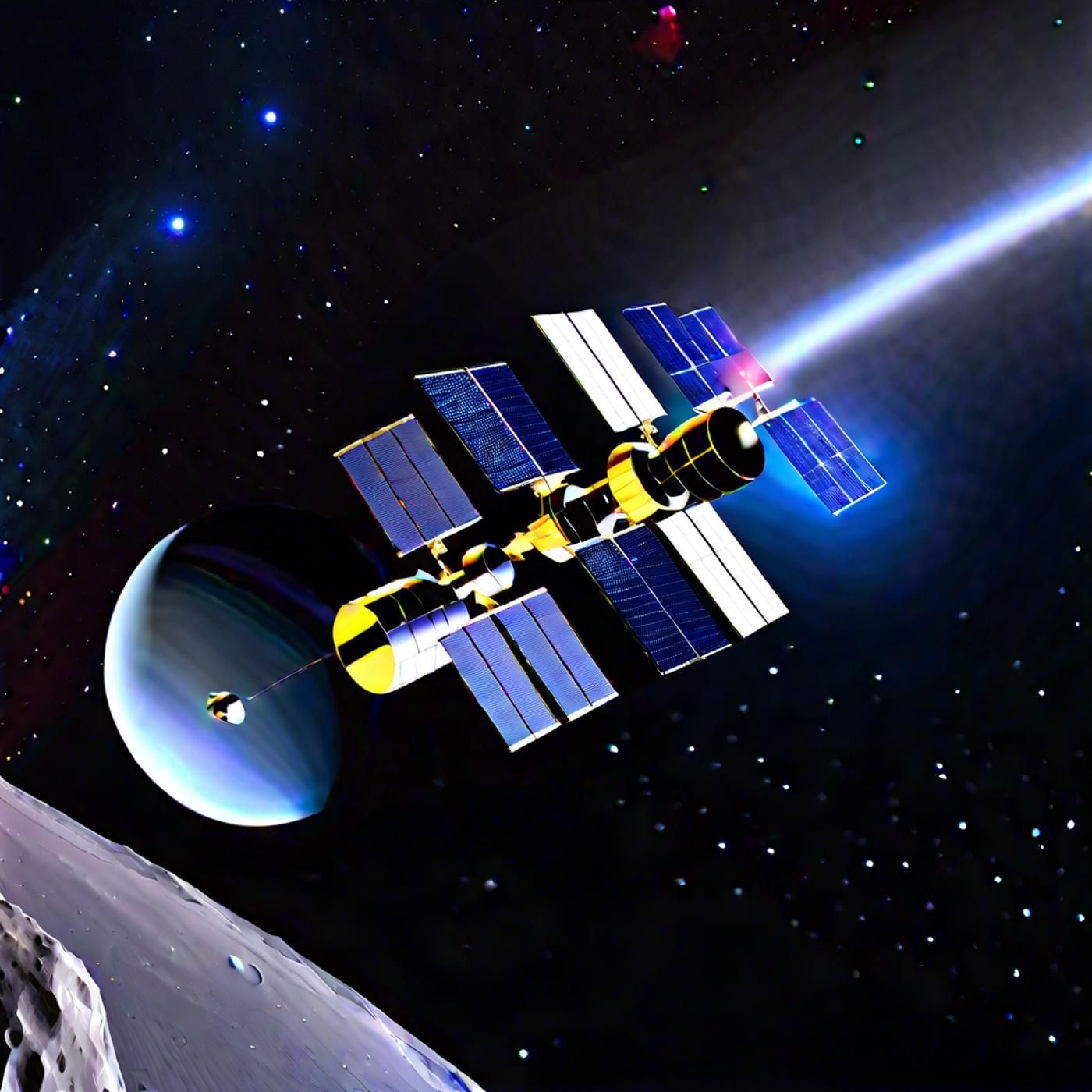S03E64: NASA's Habitable Worlds & Voyager's Revival: Pioneering Exoplanet Tech and Stellar Resilience

Embark on a celestial journey with today's episode of Astronomy Daily - The Podcast, where your host, Anna, guides you through the latest cosmic updates. We'll start with the latest advancements from NASA's future missions, including groundbreaking...
Embark on a celestial journey with today's episode of Astronomy Daily - The Podcast, where your host, Anna, guides you through the latest cosmic updates. We'll start with the latest advancements from NASA's future missions, including groundbreaking technologies for the Habitable World's Observatory. Next, we'll provide updates on Voyager 1 and its recent instrument recovery efforts. You'll also hear about new discoveries from Martian meteorites that reveal crucial information about the Red Planet's mantle and crust. Additionally, we'll discuss recent solar activity and the stunning auroras it has been producing. And as always, we'll cap it all off with even more exciting news and insights about the universe.
1) Astronomy Daily brings you the latest news in astronomy and space exploration
2) NASA announces significant advancements for the Habitable World's Observatory
3) Voyager 1's science instruments are back online after technical issues
4) Martian meteorites provide new insights into Mars' geological history
5) Recent solar activity results in breathtaking aurora displays
6) The importance of planetary protection in space exploration
7) High-resolution images of Jupiter's moon Io reveal volcanic activity
8) Vote for the new color of the iconic Lego astronaut minifigure
For an astronomical experience, visit our website at astronomydaily.io for the latest news, sign up for our free newsletter, and check out exclusive sponsor deals. Connect with us on X (@AstroDailyPod) and YouTube for engaging discussions with fellow space aficionados. This is Anna, reminding you to keep your gaze fixed on the heavens. Until our next stellar episode, let the cosmos ignite your curiosity and wonder. Clear skies and cosmic discoveries to all!
Support:
https://www.bitesz.com/show/astronomy-daily-the-podcast/support/
www.bitesz.com
Sponsors
www.bitesz.com/nordpass
https://www.bitesz.com/show/astronomy-daily-the-podcast/sponsors/
This podcast features the latest in astronomy news from NASA and other sources
Anna: welcome to Astronomy daily, your daily dose of space news. In today's episode, we'll be covering a range of fascinating topics that are sure to pique your interest. We'll start with the latest advancements from NASA's future missions, including groundbreaking technologies for the Habitable world's observatory. Next, we'll provide updates on Voyager one and its recent instrument recovery efforts. You'll also hear about new discoveries from martian meteorites that reveal crucial information about the red planet's mantle and crust. Additionally, we'll discuss recent solar activity and the stunning auroras it has been producing. And as always, we'll cap it all off with even more exciting news and insights about the universe. I'm your host, Anna, and let's dive into the cosmos execution, the Astronomy daily podcast.
NASA has selected three industry proposals to help develop technologies for habitable Worlds observatory
NASA recently announced a significant step forward in the quest to find life beyond our solar system. The agency has selected three industry proposals to help develop technologies for the ambitious habitable Worlds observatory mission. This mission is set to be a game changer in how we explore the cosmos as it aims to directly image Earth like planets orbiting stars similar to our sun, and analyze their atmospheres for chemical signatures that might indicate the presence of life. The selected proposals focus on advancing ultra stable telescope research and technology. This research is crucial for the habitable world's observatory, which will require an exceptionally stable optical system to capture clear images of distant exoplanets. One of the key components will be a highly advanced coronagraph designed to block out the light from stars to better observe the planets orbiting them. This ambitious project is still in its early planning stages, but with the combined expertise of government, academia, and industry, NASA is laying the groundwork for what could be one of the most groundbreaking space missions in history. Good news for Voyager one, one of NASA's longest running space missions. After a period of technical issues, two of its science instruments are back online, transmitting useful data once again. Last November, Voyager one began sending a repeating gibberish signal due to a corrupted memory chip in one of its onboard computers. This chip had likely been struck by a charged particle known as a galactic cosmic ray. Unable to replace the chip, engineers devised a software based workaround that involved moving the affected code to different locations within the computer, ensuring it could still function as a whole. The first successful test of this approach took place on April 18, with signals confirming the fix. Two days later. With the magnetometer and plasma wave subsystem back online and returning valuable science data. As of May 17, engineers are now focused on restoring the low energy charged particle instrument and the cosmic ray subsystem as far from Earth as 163 au, Voyager one continues to push the boundaries of human exploration, with its mission now focusing on the interstellar environment beyond the heliosphere. Despite its age and the challenges it faces, Voyager one's resilience is inspiring. The team hopes to extend the mission's operations through 2025 and perhaps even reach the half century mark in 2027, with both Voyager one and its twin, Voyager two exploring the vast reaches of space beyond our solar system. These iconic spacecraft continue to provide invaluable insights into the interstellar medium, cementing their place in the annals of space exploration history.
Scientists have made groundbreaking discoveries from martian meteorites collected here on Earth
Scientists have made groundbreaking discoveries from martian meteorites collected here on Earth. These space rocks, originating from Mars and ejected roughly 1.3 billion years ago, offer crucial insights into the red planet's mantle and crust. Over the years, these meteorites have been found in locations as diverse as Antarctica and Africa. Analyzing the chemical compositions of these samples, researchers have revealed detailed information about Mars geological history. These findings not only deepen our understanding of how Mars formed and evolved, but also provide valuable data to support ongoing NASA missions like insight and perseverance, as well as the upcoming Mars sample return project. Remarkably, all these meteorites appear to come from a single massive martian volcano. The research indicates that these rocks are related through a process known as fractional crystallization. This involves the separation of different minerals during the slow cooling of molten rock, painting a vivid picture of the volcanic activity that once shaped Mars surface. Doctor James Day, a geologist at the Scripps Institution of Oceanography, emphasizes the importance of these meteorites as the only physical materials we have from Mars. They allow scientists to conduct precise measurements and better understand the internal structure of the planet. This research serves as a critical ground truth for mission science, directly informing the instruments and analyses of rovers currently exploring the martian surface. These martian meteorites are fundamentally changing our understanding of Mars composition and geological processes. By studying their distinct chemical characteristics, scientists can identify different layers of Mars crust and mantle, thereby piecing together a more complete picture of its internal structure. This work not only sheds light on Mars past, but also sets the stage for future exploratory missions. Region 3697 on the sun has been causing some truly breathtaking aurora displays recently. While the region responsible for these vibrant light shows has decayed since it last faced earth, moderate geomagnetic storms from May 31 to June 1 could still treat us to auroras visible in the USA as far south as New York and Idaho. However, the longer daylight hours in many parts of the world may make it more challenging to catch these celestial displays. Auroras are the result of geomagnetic storms caused by solar activity, such as coronal mass ejections. Cmes. When these eruptions of plasma from the sun collide with Earth's magnetic field, they create stunning displays of light in the polar regions. A CME from region 3697 may enhance Earth's magnetic field, creating conditions conducive to aurora sightings. While it's uncertain if this region will replicate the spectacular events from early May, it's worth keeping an eye on the night sky, especially between 11:00 p.m. and 02:00 a.m. local time, when it's darkest. As we move into the peak of the current solar cycle in 2025, we can expect more activity and more opportunities to witness these incredible displays. So stay tuned for updates on solar activity and make sure to look up as the universe always has. A fascinating show to offer.
In today's episode, we delve into the fascinating field of planetary protection
In today's episode, we delve into the fascinating field of planetary protection. This crucial discipline aims to prevent earthborn organisms from contaminating other celestial bodies and conversely, to protect Earth from potential contaminants brought back from space missions. Planetary protection is a cornerstone of responsible space exploration, ensuring that we preserve the integrity of scientific investigations and safeguard our planet. Doctor Athena Custenis, the chair of the Committee on Space Research's Panel on Planetary Protection, emphasizes the importance of this field in our quest to find life beyond Earth. By establishing protocols to avoid cross contamination, we can conduct more accurate scientific analyses of extraterrestrial environments. This, in turn, helps us better understand the potential for life elsewhere in the universe while mitigating risks to our own biosphere. One of the key aspects of planetary protection is its role in upcoming missions to destinations like Mars and the icy moons of Jupiter and Saturn. These missions aim to explore environments that may harbor life or have the conditions necessary to support it. By maintaining strict planetary protection measures, we ensure that any discoveries made are truly representative of these alien worlds and not influenced by terrestrial contamination. As we continue to advance in space exploration, planetary protection will remain a vital practice safeguarding both our scientific endeavors and our home planet.
High resolution images of Jupiter's moon IO have been captured using Sharkvis instrument
High resolution images of Jupiter's moon IO have been captured using the Sharkvis instrument, offering an unprecedented glimpse into the surface of the most volcanically active body in our solar system. These remarkable images reveal surface features as small as 50 miles across, a, uh, feat previously achievable only by spacecraft. IO's intense volcanic activity is driven by the gravitational pull from Jupiter and its neighboring moons Europa and Ganymede, causing significant internal friction and heat. The newly captured details around the volcano Pele are particularly fascinating. Recent images show the resurfacing of Pele's surrounding areas due to eruption deposits from from a nearby volcano, Pilan Patera. This phenomenon has provided fresh insights into the processes that shape IO's surface and volcanic behavior. Such detailed observations are instrumental in furthering our understanding of tidal heating and volcanic processes, not just on IO, but also on Earth and other celestial bodies. This cutting edge technology, combining high contrast optical imaging with adaptive optic systems, opens new possibilities for studying volcanic worlds both within our solar system and beyond. Stay tuned as more discoveries from shark VIX continue to illuminate the dynamic and intriguing geology of IO, offering valuable lessons for planetary science and exploration.
You now have the chance to vote for a new color for the iconic astronaut minifigure
And finally today, Lego fans get ready for some exciting news. You now have the chance to vote for a new color for the iconic astronaut minifigure. The options to choose from include bright bluish green, bright yellowish green, reddish violet, warm gold, and dark azure. This new minifigure will be an integral part of the upcoming Lego Ideas Minifigure prize machine set, which promises to bring a fresh spark of creativity and joy to Lego enthusiasts worldwide. The voting process is simple and fun. Just head over to Lego's voting page and cast your ballot for your favorite color. You'll need to set up an account on the Lego Ideas website, but it's a quick and easy process and definitely worth it to be part of Lego history. The voting period is open until June 3 at 09:00 a.m. eDT, so make sure to participate now and help shape the future of Lego's beloved mini astronauts. Lego Ideas is a fantastic program that enables creators from around the globe to propose new designs, which are then voted on by the community. If a design garners enough support, it has the potential to be transformed into a real Lego set after review by an expert. So don't miss out on this fabulous opportunity to influence the iconic lineup of Lego spacemen. Cast your vote and make your voice heard. Thank you for tuning into Astronomy daily. For more space news and insights, make sure to visit our website at astronomydaily IO. There you'll find a constantly updating news feed, archives of all our podcast episodes, and access to our daily newsletter. Don't miss out on fantastic offers from our sponsors too, like Nordpass, Nord VPN, Protonmail, and Amazon. We've got some great deals lined up just for you. Remember to follow us on social media. You can find us on YouTube and X, formally known as Twitter, by searching for Astro DailyPod. Join the conversation and keep up with all things astronomy. Once again, I'm Anna, your host, reminding you to keep looking up at the stars and explore the wonders of the universe. Until next time, stay curious and keep your eyes on the cosmos.
New to Astronomy Daily - The Podcast?
Here are some great episodes to start with.




















